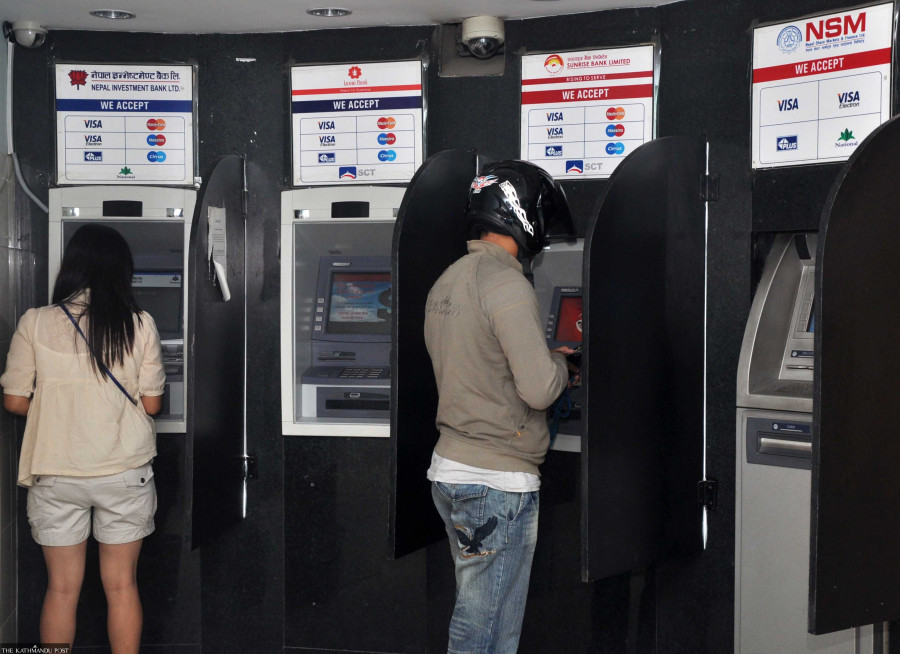Money
High interest rates delight depositors, but give businesses a hard time
The borrowing rate has reached 16 percent, making it difficult for the productive sector to survive, Nepali traders say.
Krishana Prasain
The central bank's decision to raise interest rates has hit interest-sensitive businesses as the cost of borrowing has gone up, insiders say.
High interest rates encourage saving and attract deposits amid the ongoing liquidity crisis, but many business lines that reprice monthly are having a hard time. The result is higher inflation, according to bankers and businessmen.
Nepali traders say that the borrowing rate has reached 16 percent, making it difficult for the productive sector to survive amid a liquidity crunch in the market.
“High interest rates can impact small businesses' cash flow and their ability to borrow and reinvest,” said Dinesh Shrestha, vice-president of the Federation of Nepalese Chambers of Commerce and Industry, the apex private sector body.
High interest rates even impact employment as hiring slow downs.
"It increases the cost of production, reduces the competitive capacity of the production sector, and eventually prompts more imports," said Shrestha.
“We condemn the way banks and financial institutions have increased the interest rate to 15 percent to lure deposits, and we are worried about it,” Shrestha said.
“Nowhere in the world do banks pay an interest rate higher than the country's rate of inflation,” he said. “This needs to be stopped immediately.”
According to the National Industrial Survey 2019 of the Central Bureau of Statistics, the number of large manufacturing establishments grew by a meagre 17.46 percent in 27 years due to a high-cost economy, lack of adoption of modern technology and policy that was unfriendly towards investors.
Political instability in the country has crippled the manufacturing and industrial sectors, insiders say.
The employment rate has been stagnant over the years. The survey report shows that the manufacturing sector generated only 64,707 jobs in three decades. The number of persons engaged in large-size manufacturing was 223,463 in 1991-92.
“We are looking for help from the government and Nepal Rastra Bank to provide new loans in a new way and manage the existing loan gradually,” Shrestha said. “If increasing the interest rate does not get addressed on time it will have a negative impact on the overall economy.”
The government has said in the budget statement of this year that it prioritises the increment of domestic production, but this does not seem to be true considering actions like this and it is just watching, insiders say.
The private sector has made investments by taking risks, but there is no support from the government on the investment done by the sector, they say.
"The private sector is holding a meeting on Monday to discuss interests rate and request stakeholders to overcome it," Shrestha said.
Domestic producers, mainly exporters, were already facing tough challenges due to high fuel costs, increased raw material prices and hiked shipping charges. The increased interest rate has added to the worries of manufacturers.
“In readymade garments, our prices were more than 26 percent higher compared to other countries in the global market. The increase in the interest rate has added another burden that ultimately makes our products less competitive,” said Pashupati Dev Pandey, president of the Garment Association Nepal.
“We are not getting loans. We are being provided a 25 percent loan for running capital which is not sufficient. We need at least a 75 percent loan,” said Pandey, owner of Pure Clothing, a readymade garment producing company.
“This trend increases the risk of factories closing down that may cause unemployment,” Pandey said. "The production capacity of the readymade garment industry has already declined by 50 percent."
The budget of the current fiscal year has prioritised increasing domestic production and consumption amid fast-rising imports, shrinking exports and falling local production.
It has also announced implementing programmes like domestic industry decade to increase the production and consumption of indigenous goods. But it seems like entrepreneurs are going to have another tough time.
"Interest rates have increased due to the global economic situation, inflationary pressure, import-based economy and the strengthening of the greenback,” said Anil Kumar Upadhyay, president of the Nepal Bankers’ Association.
“If we keep the interest rate lower than the rate of inflation, there are chances of money going into unofficial lending. People tend to invest in safe havens like housing and land and other unproductive sectors,” said Upadhyay, CEO of Agricultural Development Bank.
"Only around 28 percent of the depositors in the country have normal savings. Other depositors tend to invest in gold, shares and others that have a high return if they do not get timely returns on their savings," he said.
"Banks have increased the interest rate on savings three times in one year, and raised the interest rate on loans. So, to balance the market and observe the depositors and increased office expenditure, banks need to prepare a cost mechanism. The interest rate is increasing globally as well.”
According to reports, the increase in long-term interest rates has been driven by global economic recovery, which led to an increase in global demand for credit relative to global savings.
"The liquidity crisis is also another reason for increasing the system cost of banks that are maintaining it by borrowing from the central bank, and the price needs to be transferred somewhere," Upadhyay said.




 6.12°C Kathmandu
6.12°C Kathmandu














